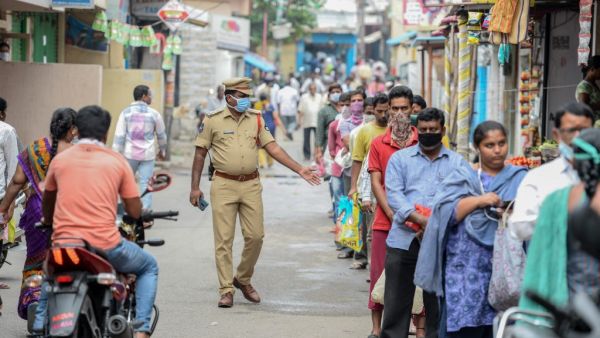The announcement of a country-wide shutdown in India last week has caused millions of migrant workers to flee major cities, resulting in huge crowds risking coronavirus infection.
The unprecedented 21-day lockdown, which in terms of people is larger than the one seen in China earlier in the year, gave the 1.3 billion citizens less than four hours to prepare, throwing the country into chaos.
With no way to make money, migrant workers who moved to India's bigger cities from villages to make a living are now desperately trying to return home. This scramble caused huge crowds to form at bus stations, captured in these videos and photographs.
In his address to the nation, Modi said: 'Forget about leaving home for the next 21 days. If you cross the threshold of your house, you will invite the virus home.' He reassured his citizens that essential services would continue, but was not clear about how people could buy food and other essential goods.
According to international labour organisations 90 percent of India's workforce work hand-to-mouth and is employed in the informal sector. Most do not have access to pensions, sick leave, paid leave or any kind of insurance.
This lack of assurance and security caused a rush on the shops with people seen lining the streets late into the night to get food. Others were desperate to get out of the cities and back to their rural homes where they can be with their family and away from the larger population hubs which have incredibly high population densities.
Footage and images coming out of Ghaziabad, on the outskirts New Delhi, show huge crowds of people waiting for transport to get out of the cities. One video shows hundreds of thousands of people crowding at a bus station, trying to cram themselves onto the buses taking people out of the city, or even climbing on top of them.
Another video shows people still waiting late into the night outside of a station. People are seen desperately climbing over barriers to get ahead of the queues. Lost children are seen walking around looking for their parents while people sit of the ground, distraught after missing their bus home.
Speaking to The Guardian, a daily wage worker Rama who has lost his job polishing office floors described the violent scenes he experienced at a bus station as he attempted to get home. He saw desperate people trying to get home being hit with wooden rods wielded by the police.
'My work has totally stopped so I have no money to survive and I have not eaten since yesterday, so that is why I needed to go back,' he said. 'But I was not the only one. The bus station was full of people like me, desperate to get out, and it was like hell.
'There were crowds and everyone was being crushed and pulling each other out of the way, there was so much violence and police were charging at us with lathis.'
'For buses that had seats [for] 100 people, 200 people would be trying to cram in, people were sitting on top of the bus and hanging out of the windows. We were all desperate to leave because we cannot survive in Delhi under this lockdown,' Rama said.
Making the situation worse, some bus and train services have ceased with the lockdown, causing even more overcrowding. In some cases, people were left with no other option but to begin walking home, often living hundreds of miles outside the cities.
The roads leading away from the cities quickly became lined with people carrying their belongings down dusty sidewalks. Even for them it has been nearly impossible to escape the crowds in which the chances of coronavirus infection are greatly increased.
The crammed crowds at Delhi's bus stations is the opposite of what Modi intended with the lockdown that was announced last week, with people in the country horrified at the events being played out at India's transport hubs.
Not only has the lockdown put some of India's most impoverished vulnerable people in a situation where they will struggle to pay for rent and food, it is also increasing the likelihood of the coronavirus spreading both among those in the city and across the country.
Anyone travelling who has caught the virus by being in close contact with others will now likely spread it to the more remote parts of India. In reaction to this, a number of villages are attempting to stop migrant workers from returning home out of fear they are braining the virus back with them.
Others have converted schoolhouses and government buildings into quarantine centres to house the countless working migrants that will be returning home, to help manage the influx of people and monitor for symptoms.
Prime Minister Modi has announced a $22.5 (£18.2) billion relief package to help the country's poorest people get the essential items they need to live off. The government intends to use existing welfare schemes to roll out relief measures which include free food and money transfers to low-income earners.
However, low-wage earners will receive 500 rupees each (£5.30) a month, just a fraction of what they would have been earning in the cities.
Strong measures are being taken by Indian authorities against those who break the coronavirus lockdown measure put in place last Tuesday.
One example given by an Indian Police Chief in Chandigarh, in the North of India, is that a cricket stadium has been converted into a 'temporary jail' to inprison those who have violated the country's lockdown conditions.
'We round up people we find loitering on the street who are violating the lockdown conditions and bring them to the jail to brief them about social distancing, we provide them with food and tell them about proper sanitisation, and they are let go by evening,' Chandrajit Singh, Chandigarh Police's public relations officer said to CNN.
India's confirmed coronavirus cases is low compared to other countries, particularly considering it's population, with just 1,251 confirmed and 31 deaths according the latest figures from the Johns Hopkins University. However, the rate of testing is also low and the number is likely much higher.
This article has been adapted from its original source.










